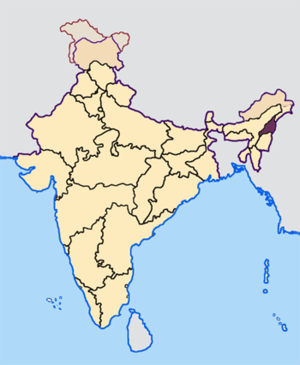Ao languages
| Ao | |
|---|---|
| Central Naga | |
| Ethnicity | Ao Naga |
| Geographic distribution | Nagaland, India |
| Linguistic classification |
Sino-Tibetan
|
| Subdivisions |
|
| Glottolog | aoic1235[1] |
 Nagaland | |
The Ao languages or Central Naga languages are a small family of Sino-Tibetan languages spoken by the Ao of north-central Nagaland in northeast India. Conventionally classified as "Naga", they are not clearly related to other Naga languages, and are conservatively classified as an independent branch of Sino-Tibetan, pending further research. There are around 607,000 speakers of the languages in total.
Coupe (2012)[2] considers the Angami–Pochuri languages to be most closely related to Ao as part of a wider Angami–Ao group.
Languages
The following languages are widely accepted as Ao languages:
- Chungli Ao
- Mongsen Ao
- Sangtam ('Thukumi')
- Yimchungrü ('Yachumi')
- Lotha (Lhota)
There are also various undescribed Ao 'dialects,' including Yacham and Tengsa, which may turn out to be separate languages (see Mongsen Ao).
The following "Naga" languages spoken in and around Leshi Township, Myanmar are classified as Ao languages ("Ao-Yimchungrü") by Saul (2005).[3]
The four languages above are listed as unclassified Kuki-Chin-Naga languages in Ethnologue. Bruhn (2014:370) also surmises that Makury may be an Ao language.
Bruhn (2014) uses the term Central Naga to refer to all of the languages above, and uses the Ao to refer to only two languages, namely Chungli Ao and Mongsen Ao. The internal structure of Bruhn's Central Naga group is as follows.
- Central Naga
Ao language cluster
(Note: The Ao language cluster described here does not include the Lotha, Sangtam, and Yimchungrü languages.)
Ethnologue lists the following varieties of Ao.
- Mongsen Khari
- Changki
- Chongli (Chungli)
- Dordar (Yacham)
- Longla
Chongli and Mongsen are nearly mutually unintelligibile.

Mills (1926) lists the Ao Naga tribes of Nagaland as speaking three languages: Chungli, Mongsen, and Changki. Chungli Ao and Mongsen Ao are spoken in majority of the Ao villages, whereas Changki speakers form the minor speakers.
Mongsen Ao is spoken primarily in the western part of Ao territory.
Changki Ao is spoken only in 3 villages - Changki, Japu and Longjemdang - which is poorly documented though reportedly related to Mongsen Ao. Some Changki speakers can fluently converse in both Mongsen and Chungli, but a Mongsen Ao cannot speak Changki or understand it, whereas a Chungli can hardly understand or speak Changki. Chungli Ao and Mongsen Ao are not mutually intelligible.[4]
The speech of each Ao village has its own distinctive characteristics. Many villages contain both Chungli and Mongsen speakers.
Reconstruction
Proto-Central Naga (Proto-Ao) has been reconstructed by Bruhn (2014).
Bruhn (2014:363) identifies the following four sound changes from Proto-Tibeto-Burman (PTB) to Proto-Central Naga (PCN) as sound changes that are characteristic of the Central Naga branch.
- PTB *-a(ː)w, *-əw, *-ow, *-u > PCN *-u(ʔ) ‘back diphthong merger’
- PTB *-r > PCN *-n ‘*r-coda nasalization’
- PTB *-s > PCN *-t ‘*s-coda occlusivization’
- PTB *-i(ː)l, *‑al, *‑uːl > PCN *‑ə(ʔ) ‘*l-rime erosion’
See also
References
- ↑ Hammarström, Harald; Forkel, Robert; Haspelmath, Martin, eds. (2017). "Aoic". Glottolog 3.0. Jena, Germany: Max Planck Institute for the Science of Human History.
- ↑ Coupe, Alexander R. 2012. Overcounting numeral systems and their relevance to sub-grouping in the Tibeto-Burman languages of Nagaland. Language and Linguistics / Academica Sinica 13. 193-220.
- ↑ Saul, J. D. 2005. The Naga of Burma: Their festivals, customs and way of life. Bangkok, Thailand: Orchid Press.
- ↑ Escamilla, R. M. (2012). An Updated Typology of Causative Constructions: Form-Function Mappings in Hupa (California Athabaskan), Chungli Ao (Tibeto-Burman), and Beyond. Unpublished PhD dissertation, U.C. Berkeley.
- van Driem, George (2001). Languages of the Himalayas: An Ethnolinguistic Handbook of the Greater Himalayan Region. Leiden: Brill.
- Bruhn, Daniel Wayne. 2014. A Phonological Reconstruction of Proto-Central Naga. Ph.D. dissertation. University of California, Berkeley.
- Saul, J. D. 2005. The Naga of Burma: Their festivals, customs and way of life. Bangkok, Thailand: Orchid Press.
- Barkman, Tiffany. 2014. A descriptive grammar of Jejara (Para Naga). MA thesis, Chiang Mai: Payap University.
- Shi, Vong Tsuh. 2009. Discourse studies of Makuri Naga narratives. MA thesis, Chiang Mai: Payap University.
- Language and Social Development Organization (LSDO). 2006. A sociolinguistic survey of Makuri, Para, and Long Phuri Naga in Layshi Township, Myanmar. Unpublished manuscript.
- Mills, J. P (1926). The Ao Nagas. London: MacMillan & Co.